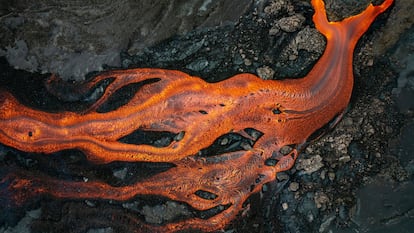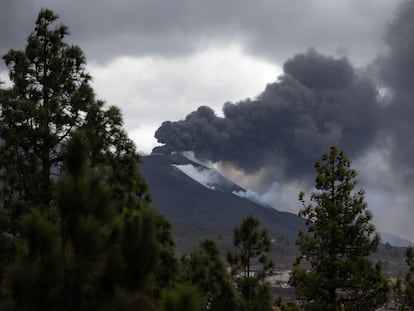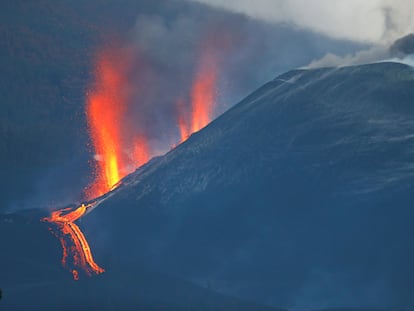Volcanic eruption on La Palma shows signs of less intensity
Recent slowdown in lava flow makes it possible to end the evacuation of parts of Los Llanos de Aridane, but around 600 people are still unable to return to their homes

Volcanic activity on the Spanish island of La Palma continued on Thursday, but with less intensity than in recent days. Residents of this corner of the Canary Islands, off the northwestern coast of Africa, have been dealing with lava, ash and earthquakes since September 19, when the first vent opened up inside the Cumbre Vieja natural park.
The molten rock flowing down in different directions from the volcano has not affected new areas in the last few hours, and is instead running over and through existing lava streams, according to Miguel Ángel Morcuende, the technical director of the team of experts monitoring the eruption, the Volcano Risk Prevention Plan of the Canary Islands (Pevolca). “The energy is flowing inside the lava channels, through the central area and heading west,” said Morcuende.
The news was not so good on Tuesday, when experts reported that lava from a vent that opened up west of Cogote mountain had destroyed 60 buildings in just 36 hours near Las Hoyas.
This recent slowdown in the lava flow on the northwest side of the volcano has led authorities to end the evacuation of Nicolás Brito País street as well as Las Martelas de Abajo, both located within the municipality of Los Llanos de Aridane, according to Pevolca.
But there are still 555 people staying in hotels after being evacuated from their homes, most of them in Fuencaliente. Another 43 individuals are temporarily housed in care homes.
Five small earthquakes were detected in the early hours of Thursday by the National Geographic Institute (IGN); the largest one measured 2.9 on the Richter scale and took place at a depth of 15 kilometers under the municipality of Fuencaliente at 5.03am. Ash levels were also expected to remain low enough to allow normal airline operations on Thursday afternoon.
Más imágenes del avance de la colada de lava en el cantil desde el mirador de Las Hoyas a las 9.50 hora canaria / More images of the advance of the lava flow in the cliff from the Las Hoyas viewpoint at 9.50 am Canarian time pic.twitter.com/Bdg9VpWNSh
— INVOLCAN (@involcan) December 8, 2021
Earthquakes are one of the indicators used by scientists to estimate how long an eruption might last, along with sulfur dioxide emissions (SO₂) and vibrations caused by the flow of gas and magma.
The affected surface area is now 1,184 hectares, according to the latest available data, including approximately 360 hectares of cropland. A total of 1,628 buildings have been damaged by the volcano since September 19, according to local property records.
The Spanish government has earmarked €130 million to help residents of La Palma who have been affected by the eruption. Félix Bolaños, the minister in charge of prime ministerial affairs, said on Wednesday that the government is ready to process around a thousand claims a week, and that it hopes to have processed all requests for aid by the end of the year.
“Our mission with the island of La Palma will end on the day that we rebuild it and that life projects that were cut short by the volcano get back on track,” he said.
The ongoing eruption, which is taking place on the western face of a mountain range that cuts down the middle of La Palma, will go down in the history books as the one that caused the most damage on an island with a registered population of around 82,000. Experts now believe that the volcanic activity that began on September 19 also has a good chance of becoming La Palma’s longest eruption in 500 years.
Tu suscripción se está usando en otro dispositivo
¿Quieres añadir otro usuario a tu suscripción?
Si continúas leyendo en este dispositivo, no se podrá leer en el otro.
FlechaTu suscripción se está usando en otro dispositivo y solo puedes acceder a EL PAÍS desde un dispositivo a la vez.
Si quieres compartir tu cuenta, cambia tu suscripción a la modalidad Premium, así podrás añadir otro usuario. Cada uno accederá con su propia cuenta de email, lo que os permitirá personalizar vuestra experiencia en EL PAÍS.
¿Tienes una suscripción de empresa? Accede aquí para contratar más cuentas.
En el caso de no saber quién está usando tu cuenta, te recomendamos cambiar tu contraseña aquí.
Si decides continuar compartiendo tu cuenta, este mensaje se mostrará en tu dispositivo y en el de la otra persona que está usando tu cuenta de forma indefinida, afectando a tu experiencia de lectura. Puedes consultar aquí los términos y condiciones de la suscripción digital.
More information

How the volcanic eruption is affecting La Palma’s pine forests

As new vents open in La Palma, experts say volcanic eruption could be longest in 500 years
Últimas noticias
Most viewed
- Reinhard Genzel, Nobel laureate in physics: ‘One-minute videos will never give you the truth’
- Oona Chaplin: ‘I told James Cameron that I was living in a treehouse and starting a permaculture project with a friend’
- Pablo Escobar’s hippos: A serious environmental problem, 40 years on
- Charles Dubouloz, mountaineering star, retires at 36 with a farewell tour inspired by Walter Bonatti
- Why we lost the habit of sleeping in two segments and how that changed our sense of time








































